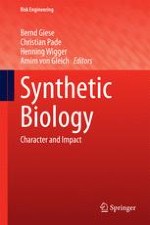2015 | OriginalPaper | Buchkapitel
Synthetic Biology and Genetic Engineering: Parallels in Risk Assessment
verfasst von : Broder Breckling, Gunther Schmidt
Erschienen in: Synthetic Biology
Aktivieren Sie unsere intelligente Suche, um passende Fachinhalte oder Patente zu finden.
Wählen Sie Textabschnitte aus um mit Künstlicher Intelligenz passenden Patente zu finden. powered by
Markieren Sie Textabschnitte, um KI-gestützt weitere passende Inhalte zu finden. powered by
